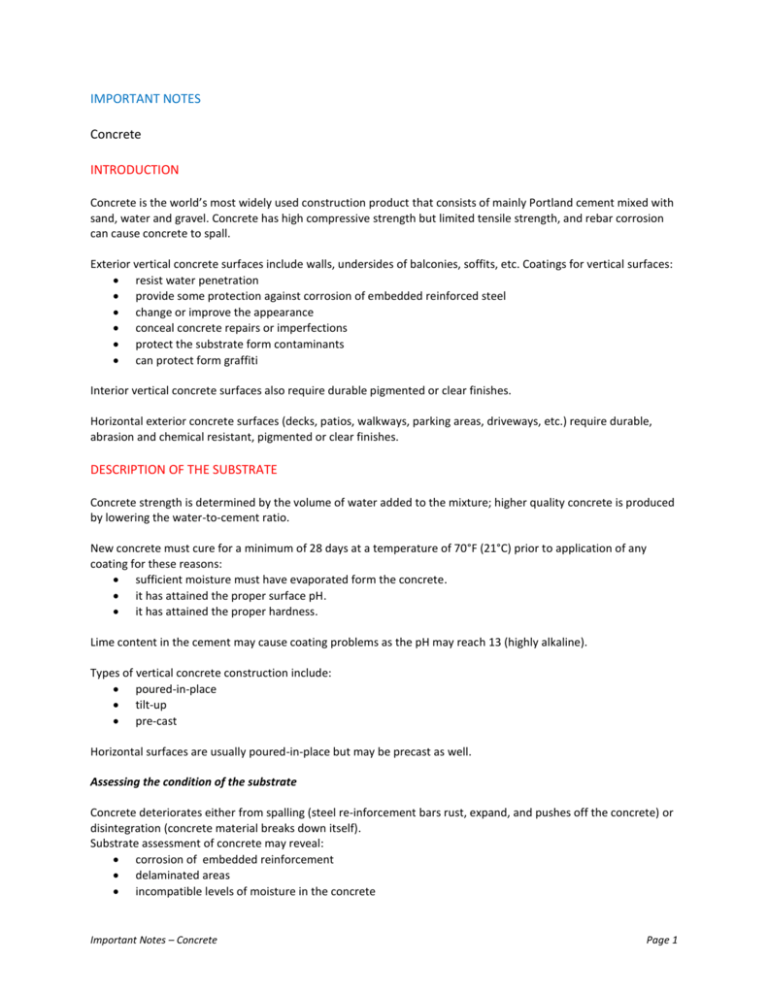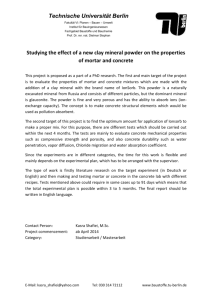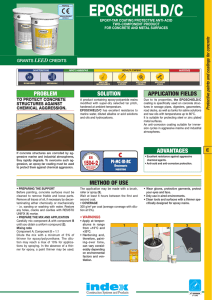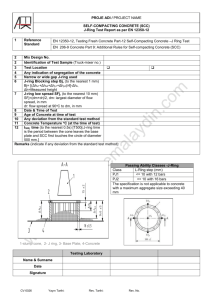IMPORTANT NOTES Concrete INTRODUCTION Concrete is the
advertisement

IMPORTANT NOTES Concrete INTRODUCTION Concrete is the world’s most widely used construction product that consists of mainly Portland cement mixed with sand, water and gravel. Concrete has high compressive strength but limited tensile strength, and rebar corrosion can cause concrete to spall. Exterior vertical concrete surfaces include walls, undersides of balconies, soffits, etc. Coatings for vertical surfaces: resist water penetration provide some protection against corrosion of embedded reinforced steel change or improve the appearance conceal concrete repairs or imperfections protect the substrate form contaminants can protect form graffiti Interior vertical concrete surfaces also require durable pigmented or clear finishes. Horizontal exterior concrete surfaces (decks, patios, walkways, parking areas, driveways, etc.) require durable, abrasion and chemical resistant, pigmented or clear finishes. DESCRIPTION OF THE SUBSTRATE Concrete strength is determined by the volume of water added to the mixture; higher quality concrete is produced by lowering the water-to-cement ratio. New concrete must cure for a minimum of 28 days at a temperature of 70°F (21°C) prior to application of any coating for these reasons: sufficient moisture must have evaporated form the concrete. it has attained the proper surface pH. it has attained the proper hardness. Lime content in the cement may cause coating problems as the pH may reach 13 (highly alkaline). Types of vertical concrete construction include: poured-in-place tilt-up pre-cast Horizontal surfaces are usually poured-in-place but may be precast as well. Assessing the condition of the substrate Concrete deteriorates either from spalling (steel re-inforcement bars rust, expand, and pushes off the concrete) or disintegration (concrete material breaks down itself). Substrate assessment of concrete may reveal: corrosion of embedded reinforcement delaminated areas incompatible levels of moisture in the concrete Important Notes – Concrete Page 1 Repair of the underlying problem must be done prior to application of a coating. Moisture moves through concrete by hydrostatic pressure, capillary action, and moisture vapor pressure, which is a combination of temperature and humidity interactions. The source and migration of the moisture must be addressed. Repair work of any concrete should be done by properly trained and experienced contractor. Likely causes of paint failures on vertical concrete: alkalinity poor initial surface prep cracking from ground movement initial surface had not cured the required 28 days Failures on horizontal surfaces: abrasion or damage from heavy use stains caused by spills, dirt etc. fading from exposure blistering or delamination from moisture problems lifting, peeling or delamination from improper surface prep on the previous coating Surface contaminants: curing compounds chemical contaminants efflorescence bond breakers/form release agents rust stains mold & mildew oil, tar, grease and gum Surface Defects: bug holes honeycombs laitance & eggshell fins metal rods/tie wires sacked surface excessive smoothness/hardness ASSESSMENT & DSD LEVELS Here is a list of the defects that can occur on concrete: alligatoring blistering cedar stains checking cracking dirt/dust efflorescence erosion/chalking flaking/peeling mildew oils/grease rust stains Important Notes – Concrete Page 2 sagging smoke stains water stains Each level of DSD (degree of surface degradation) will determine the level of the defect and the surface prep. DSD Levels include: DSD 0 – no damage present DSD 1 - slightly deteriorated concrete/masonry DSD 2 – moderately deteriorated concrete/masonry DSD 3 – severely deteriorated concrete/masonry DSD 4 – substrate damage concrete/masonry CRITERIA FOR CHOOSING THE RIGHT COATING Considerations for vertical concrete: breathability (coating must be porous enough to allow water vapor to migrate through the concrete surface and evaporate) what type of finish is desired is an elastomeric coating required Key characteristics for exterior concrete coatings: water vapor should be able to more through the concrete coatings should be able to withstand wind-driven rain coatings should be able to withstand 1000 hours of UV exposure coating must be able to withstand changes in concrete volume due to changing temperatures coating must be resistant to alkali (soluble salts) Considerations for Horizontal Concrete Breathable (high permeance – allows moisture vapor to pass through) versus moisture barrier (low permeance – keeps the liquid from passing through the coating on the concrete). Issues to consider when choosing the system: required turn-around time - length of time required for application and curing surface prep constraints – does it require aggressive surface preparation? design life of the building and maintenance – consider a coating that is easy to repair or maintain operational requirements – what physical or mechanical stress are likely? UV resistance – green buildings with large windows and skylights – enhanced UV resistance may be required Color COATING PRODUCTS & SYSTEMS Surface finish: Flat – improves uniformity of slightly rough surfaces. Low Sheen – (MPI GL 3-4) will minimize the visibility of surface imperfections and improve the resistance to dirt retention and surface marking Semi-gloss & high gloss – will reduce dirt and dust accumulation and are easily cleaned but should be reserved for smooth surfaces. Interior or exterior surfaces Latex systems – form a permeable film that allows water vapor to pass through. Textured coatings – a latex paint is sometimes specified as the final coat to seal the surface without reducing the textured appearance. Important Notes – Concrete Page 3 Epoxy coatings – these are preferred for higher traffic areas and areas where resistance to abrasion, chemicals and solvents is required. Epoxies used in exterior situations may be top-coated with a 2 part aliphatic urethane coatings to protect them for the harmful UV rays. Polyurethanes - also resist strong solvents that may be required for graffiti removal. Exterior Surfaces Water repellants o Provide a surface that causes water to bead & roll off. o Intended for above grade applications. o Coated surface will appear darker than uncoated surface. Sealers o Allow water vapor to escape from the concrete. o Can protect against wind-driven rain o Available in paintable (can be re-coated)and non-paintable systems (non drying silicone oil). Graffiti-Protection coatings o Available in water based and solvent based formulas o Three types of mechanism – Permanent film that resists marking can be cleaned (clear or pigmented). Semi-permanent film that can be repeatedly cleaned with some effort. “Sacrificial” film that is removed quickly along with the markings and easily re-applied. Elastomerics o Thick film o Low water permeable o Flexible coating o Should be applied pin hole free according to the manufacturer’s instructions High Build Acrylic/Latex coatings o possess high tensile strength without the ‘stretchiness’ of elastomerics. o provide water repellency, durability and protection. o concrete must be fully cured prior to this coating as it is not designed for highly alkaline surfaces. Concrete Stains o Alter the color of the concrete. o Clear sealer topcoat will increase the durability. Horizontal Surfaces o o Surface finish and non-skid o Low gloss finishes reduce the visibility of surface defects but are prone to damage by abrasion. o Glossy finishes are more durable but may create a slick walking surface in damp or high traffic areas. Non-slip additives are often used on stairways or in areas that may become wet or damp. o Epoxy non-slip coatings are usually used in commercial, industrial and public locations where enhanced chemical and abrasion resistance is required. Mild to Moderate Service o Latex products – most often used on surfaces previously coated with a similar product. o Exterior service – high solids latex – excellent alkali resistance, good resistance to fading and sunlight and more permeable to moisture. o Clear Sealers – can be used over stained or coated surfaces to protect from chemicals, moisture, abrasion and dirt. o Zone/Traffic Marking Paints – available in both water based and solvent based products. Alkyds show better early water resistance but latex products have longer bead retention, less cracking and wear almost as well as the alkyds. These products are often sprayed and should be applied prior to the application of any sealer. Important Notes – Concrete Page 4 o o Concrete stains – there are three categories – chemically-reactive (acid) stains, non-reactive (dyes) stains and opaque stains. Surface prep is critical. Previously stained floors may require high pressure blasting or mechanical abrasion (for complete removal) prior to coating. Higher Performance Coatings o Epoxy coatings form a tough, glossy surface that are resistant to chemicals, solvents and abrasion. o Polyurethanes – available as both thin-film and high build coatings that offer excellent gloss retention, abrasion, chemical, stain and wear resistance. o Methyl Methacrylic (MMA) – can be formulated into a 100% solids product that has a rapid and cold temperature cure time. Their only drawback is a strong odor which requires very good ventilation during application and cure time. SURFACE PREPARATION The goal of surface prep is to: Clean the surface of contaminants and weakened surface layers. Fix surface defects. Provide surface roughness (profile) for good adhesion. Final clean to remove surface dust. Concrete surface Prep Methods Chemical cleaning/detergent scrubbing – hot water and TSP or other detergents to remove contaminants. Chemical stripping – alkaline chemicals to remove or soften cured coatings for subsequent mechanical removal. Acid etching – old coating must be removed first, then etching provides a lightly profiles surface. Water blasting – pressurized water to clean the surface. Moisture readings must be taken prior to coating. Impact tools – to remove existing coatings (scarifiers, planing tools, scabblers, etc.). Power tools - grinding, sanding, wire brushing to remove existing coatings. Abrasive blasting – goal is to roughen the surface without causing damage. Two methods dry or wet blasting (SSPC-SP 13/NACE No. 6). Sodium bicarbonate blast cleaning – “soda blasting” is a wet abrasive method using soda bicarbonate. Portable shot blasting – is an effective method of removing existing coatings and contamination and profiling horizontal concrete surfaces without water or chemicals (high velocity steel shot). Removing surface contaminants Cleaning heavy deposits of oil, grease or other dirt should always be done prior to other surface prep otherwise these surface contaminants could be driven into the substrate. Efflorescence – typically removed by power washing but may require chemical cleaners or a mild acid wash. Form release/bond breakers, oil & grease – hard films removed by mechanical means but grease and oil may be removed using a suitable detergent followed by a thorough rinsing. Allow proper drying prior to coating application. Soluble salts (chlorides and sulfates) – pressure washing with hot water (140° to 180°F). Rust stains – can be removed with an oxalic acid treatment as described in MPI Standard EXT 1.5 Rust Stain Removal. Extreme care must be taken and the surface must be thoroughly rinsed. Mold & mildew – removed by a bleach solution. Dust – preferably removed by vacuum. MPI Repainting Surface Preparation Guides DSD - 0 This is an essentially "sound" surface. It may have visual defects, but the film is still protective. It may simply need a color, sheen, or other change. Other than proper cleaning of the surface Important Notes – Concrete Page 5 DSD - 1 DSD - 2 DSD - 3 DSD - 4 and dulling of glossy surfaces no other surface prep is necessary. This is a "slight" degree of surface degradation. It is unlikely that the topcoat has been anything but insignificantly breached, and in no case is the substrate exposed. Surface preparation requirements should be "slight", cleaning and then only "touch up" with the top or intermediate coat should be necessary. This is a "moderate" degree of surface degradation. Damage to the film integrity is such that 'spot priming' should, in most cases, be adequate, after moderate surface preparation requirements (i.e. removal of any loose or flaking paint). This is a "severe" degree of surface degradation. The surface of the concrete may show moderate to heavy peeling, flaking, cracking, etc. Necessary surface preparation will likely be substantial, and a full coat of the appropriate primer is to be expected. This is an essentially "unsound" surface. The substrate cannot be prepared with surface prep and painting. Damaged areas require repairs or replacement. Repainting would only be a temporary cosmetic remedy. COATING APPLICATION Maintain proper environmental conditions during surface prep, painting and curing time. Exposed metal in the concrete must be suitably prepared and then primed with an anti-corrosive primer . Film uniformity & pinholes – back rolling can help to fill the irregular surfaces and provide a more even surface. High performance floor coatings (e.g. epoxy and polyurethanes) must be applied by a trained contractor. INSPECTION & QUALITY CONTROL Checklist for an inspector: Review the specifications. Inspect any concrete repair work that has been done. Verify concrete quality (soundness). Check the pH of the concrete. Measure for moisture – moisture meters, various ASTM methods. Assure that environmental conditions are maintained throughout the project. Assure film thickness of the coating(s). Test for adhesion to the substrate (previous coating). Important Notes – Concrete Page 6







